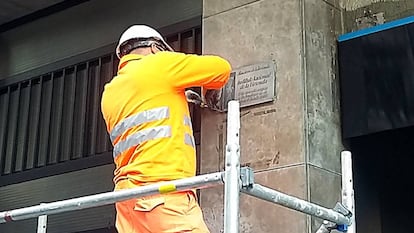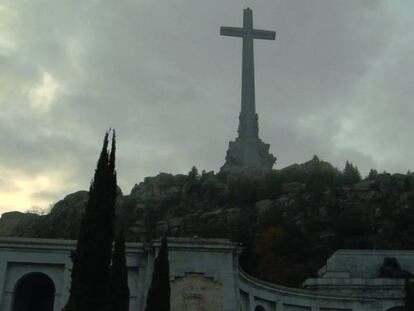Barcelona takes down Franco-era building plaques
City Hall estimates there are 367 commemorative signs left to remove in Gràcia and Nou Barris

The city of Barcelona has begun taking down 367 commemorative plaques dating back to the Franco era and which were still on view in buildings across the districts of Gràcia and Nou Barris. The plaques were placed on buildings erected during the dictatorship by the National Housing Institute, and bear the yoke and arrows that symbolized the fascist Falange movement.

Although there are parts of the city where civil groups and even residents themselves have taken down these plaques from their own buildings, the Historical Memory Law of 2007 states that it is up to local authorities to eliminate all public vestiges of the Franco era.
“We are not aware of any other remaining items from the Franco dictatorship,” said Ricard Vinyes, a historian who works as the city’s commissioner for Historical Memory programs.
Similar efforts in Madrid have yielded mixed results
Barcelona eliminated all references to Franco in street names and sculptures years ago. Vinyes noted that most of the remaining plaques in Barcelona are located in neighborhoods where there was a lot of construction during the 1960s. There are hardly any in older districts like Ciutat Vella, for example, because there was no space for new buildings there.
The councilors representing both districts, Eloi Badia for Gràcia and Janet Sanz for Nou Barris, celebrated the move. Authorities will request permission from building residents to take down 163 plaques in the former district and 204 in the latter. So far, there have only been two cases in which the building community has refused to have their plaque taken down.
Similar efforts in Madrid have yielded mixed results.
Passed by the Socialist central government of former Prime Minister José Luis Rodríguez Zapatero in 2007, Spain’s Historical Memory Law granted subsidies to projects such as the opening of mass graves from the Civil War. It also took into account the removal of statues and the changing of place names connected to the Franco regime. But funding was slashed when the PP arrived in power in 2011, halting many such projects throughout Spain.
English version by Susana Urra.
Tu suscripción se está usando en otro dispositivo
¿Quieres añadir otro usuario a tu suscripción?
Si continúas leyendo en este dispositivo, no se podrá leer en el otro.
FlechaTu suscripción se está usando en otro dispositivo y solo puedes acceder a EL PAÍS desde un dispositivo a la vez.
Si quieres compartir tu cuenta, cambia tu suscripción a la modalidad Premium, así podrás añadir otro usuario. Cada uno accederá con su propia cuenta de email, lo que os permitirá personalizar vuestra experiencia en EL PAÍS.
¿Tienes una suscripción de empresa? Accede aquí para contratar más cuentas.
En el caso de no saber quién está usando tu cuenta, te recomendamos cambiar tu contraseña aquí.
Si decides continuar compartiendo tu cuenta, este mensaje se mostrará en tu dispositivo y en el de la otra persona que está usando tu cuenta de forma indefinida, afectando a tu experiencia de lectura. Puedes consultar aquí los términos y condiciones de la suscripción digital.
More information
Últimas noticias
The complicated life of Francesca Albanese: A rising figure in Italy but barred from every bank by Trump’s sanctions
How Japan is trying to avert ‘digital defeat’
Half of Scotland is in the hands of 420 property owners
Reinhard Genzel, Nobel laureate in physics: ‘One-minute videos will never give you the truth’
Most viewed
- Pablo Escobar’s hippos: A serious environmental problem, 40 years on
- Why we lost the habit of sleeping in two segments and how that changed our sense of time
- Charles Dubouloz, mountaineering star, retires at 36 with a farewell tour inspired by Walter Bonatti
- Reinhard Genzel, Nobel laureate in physics: ‘One-minute videos will never give you the truth’
- The Florida Keys tourist paradise is besieged by immigration agents: ‘We’ve never seen anything like this’










































